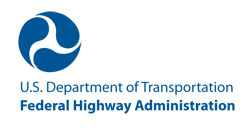PDF Version [214KB] 
PDF Files may be viewed with Adobe Acrobat Reader
Measuring Border Delay and Crossing Times for Freight
El Paso-Ciudad Juarez Bridge of the Americas
The U.S. Department of Transportation, Federal Highway Administration (USDOT/FHWA) is conducting several projects to measure truck crossing and delay time at major U.S. land ports of entry. The projects will identify and evaluate technologies that 1) can easily and precisely measure commercial vehicle crossing time, 2) are readily transferable to other ports of entry, and 3) can measure passenger-vehicle crossing time.
Project Description
FHWA's Office of Freight Management and Operations is measuring the time required for trucks to cross the Bridge of the Americas and to establish a baseline dataset. The first phase of the
project, now completed, selected Radio Frequency Identification (RFID) technology to implement
and evaluate.
The second phase of the project is now underway and focuses on six tasks.
- Task 1. Contact project stakeholders
- Task 2. Evaluate technologies
- Task 3. Develop implementation plan
- Task 4. Demonstrate technology effectiveness
- Task 5. Evaluate results
- Task 6. Prepare final report
Task 1
The project team identified project stakeholders from the El Paso area, discussed their needs, and assessed related impediments to collecting crossborder travel time data successfully. Stakeholders included representatives of motor carriers, state and local transportation planning and operations agencies, U.S. and Mexico customs, and FHWA. Several Task 1 reports have been completed: 1) Current State Analysis, 2) Preliminary Design, and 3) Written Plan for Collecting Baseline Data. They are available at http://tti.tamu.edu/projects/project_details.htm?id=2497.
Task 2
The project team conducted a test to demonstrate RFID capability in calculating travel time in a realworld
setting. The test used TxTags (RFID tags issued to motorists who automatically pay highway tolls in Texas) to measure the travel times of passenger vehicles as they passed two measurement locations that were
temporarily installed by the project team in the Austin area. The technology assessment and the final design
document have been completed and are available at the Web site noted in Task 1.
Task 3
The project team is now developing a final implementation plan. RFID readers will be installed at the entrance to the Mexican export lot on the Mexican side of the border and at the exit of the border safety inspection facility on the U.S. side of the border. The physical layout of the Bridge of the Americas is shown
in the figure.
As part of the implementation plan, an on-site test was conducted to assess RFID's ability to automatically
collect commercial vehicle crossing-time data at the bridge. The on-site test collected travel time data for
commercial vehicles by using RFID tags issued by U.S. Customs and Border Patrol, as part of the Free and
Secure Trade program, and tags issued by the Texas Department of Public Safety. The on-site test confirmed
that an RFID-based system can be used to calculate travel times for commercial vehicles at the bridge and,
more importantly, proved that RFID readers could be configured to read multiple types of RFID tags commonly
used at major U.S. land ports of entry.
|
The physical layout of the Bridge of the Americas is shown in a satellite photo. Lots and inspection facilities discussed in the caption are circled on the photo. Potential RFID sites located along the highway route leading to and away from the bridge are labeled R1 through R5.
Physical Layout of the Bridge of the Americas
Sources: Google Earth and Texas Transportation Institute
Inspection areas are outlined in red. A is the Mexican Export Lot, B is the U.S. Federal Inspection Compound, and C is the Border Safety Inspection Facility.
The northbound border crossing route is marked by orange directional arrows. If a truck is selected for secondary inspection in any of the three facilities, then it will follow the path indicated by the yellow directional arrows.
Potential sites for RFID equipment are marked in green and labeled R1 through R5. R1 and R5 represent locations where RFID equipment must be installed in order to calculate the total crossing times for each commercial vehicle passing through the system. R2, R3, and R4 represent locations where additional RFID equipment could be installed in order to segment the trip, thus providing more detailed crossing data.
|
Next Steps (Tasks 4, 5, and 6)
The installation of permanent measuring sites at the Bridge is the next step (Task 4). Data collection has been funded at locations R1 and R5, which will allow for the measurement of northbound crossing times after the technology is installed in May 2009. Other locations (R2, R3,
and R4) shown on the map can be integrated into the system if segmented trip-time data collection is
needed and funding is available.
Task 4 also will address communication, manipulation, and storage issues as well as information dissemination. This task will conclude with the installation of an RFID-based system to measure northbound commercial vehicle crossing times at the Bridge and the collection of on-site data, which is scheduled to begin in early 2009.
As the project progresses towards its goal of implementing a sustainable system to calculate crossing times at the Bridge of the Americas, the results of the data collection and information gathering efforts will be evaluated (Task 5), and completed reports will be published on the project Web site as they become available (Task 6).


